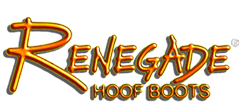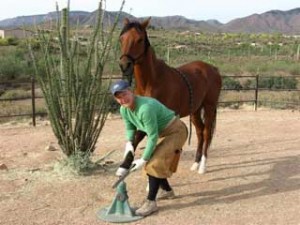The Barefoot Endurance Horse
by Kristin Walker
There are few endurance rides that you will go to these days without noticing the sometimes barefoot, mostly booted horses running down the trail.
So what’s up with that?
Through scientific research and experience, many have come to know that it is best to keep a horse as natural as possible. Come to find out, many of the ways we treat our horse’s hooves is doing damage. People are coming to barefoot for a number of reasons. Whether it is healing out of pathology, or as a measure of prevention, horse and rider are back on the trail performing.
We are seeing this in all regions, all over our country and across the world. So why are riders making this choice and how are we helping to get our horses to a high level of barefoot performance?
It is a matter of health. Proper blood circulation through movement is very important for the horse. Without it, the hoof wall becomes weak, thin and unable to hold a shoe. In order to get the best circulation, the foot needs to work properly. Hoof mechanism, the ability for the heel of the foot to expand when loaded, the loading of the sole from the ground, and the ability of each side of the heel to twist and torque builds a good foot.
Hoof mechanism is the necessary ingredient to building structure in the foot. Soft tissue structures such as the digital cushion, lateral cartilages, tendons and ligaments are located towards the back of the foot. These tissues are very much affected by good pressures and stresses. They are like a muscle that must be built through weight lifting. Like the dumbbell is to the weight lifter, movement is to the horse — “Use it or lose it”.
Proper balance to the feet is important. Balanced trimming, promotes health and circulation and minimizes negative pressures and load leveraging of the hoof wall.
Choosing the right Hoof Care Provider or farrier is very important, not only for the trimming, but to help guide people with the other aspects of the horse’s life. The horse’s transition to barefoot, the diet, footing, living conditions, saddle fit, stress level, dentistry all matter. Not everyone has all the answers, but we can guide people to the abundance of information written by scientific researchers, dieticians and very experienced horse people. Your management choices will be made from what you learn.
Remember, our horse’s feet are affected by almost everything that touches their life.
As the reasons for going barefoot become more available and published throughout our magazines and organizations, the mystery is taken away from how the horses feet work, grow and are effected by our domesticated environment. More riders are becoming educated, comfortable and confident with their choice to be barefoot.
As a Natural Hoof Care Provider, I help to answer a lot of questions concerning the subject. I hope my answers to the following common questions helps to take some of the mystery out of this new movement called the “Barefoot Performance Horse”.
Q. What is Natural Hoof Care?
A. It starts with a way of thinking. Think about how an animal has evolved and should live to be happy and healthy. That’s what they truly need. It’s when we take them too far away from their natural way of living that we get them into trouble. Horses have lived without us for thousands of years. Domestication is the culprit. We all do it to our horses. But… we can achieve a more natural way through our horse keeping methods.
Q. Can my horse go barefoot?
A. “Well, sure.” It is important that you find an educated trimmer to help you through the transition period to high performance. They will help to set expectations as to the current condition of the feet, the time it will take to become a performance barefoot horse, and how to manage the process. All aspects of the horse’s life should be addressed.
Q. Can a horse really perform barefoot?
A. Yes, we see them all over the 25 mile to 100 mile endurance trails.
Q. What are the characteristics of a good footed horse?
A. Soundness, a wide heel and frog, thick hoof wall, concavity, balance, connection of the hoof to horse seen in the white line, to name a few.
Q. What are the characteristics of a bad footed horse?
A. Lameness, contracted heels, long toes, high heels, thin hoof wall, flat feet, thrushy bacteria filled frogs and flaring of the hoof wall, to name a few.
Q. Is it possible for a barefoot horse to do an endurance ride barefoot?
A. It is possible if the horse’s hooves are healthy and conditioned for it. Nothing we do with horses is 100% natural, in particular riding them between 25 and a 100 miles at a fast pace over varied terrain. So booting them is a great precaution.
Q. Will my horse be sore when he goes barefoot?
A. Possibly. Every horse is different. Each has their own conformation, genetics, and set of circumstances. When the hoof and nerve endings start to work properly the horse regains the sensitivity he should have in his feet. No horse should be sore, but as they begin to heal and grow a better foot, what we may sense as soreness does go away. The good news is, horses do not necessarily have to grow a whole new foot to become sound and able to achieve high performance.
Q. Will boots interfere with Natural Hoof Mechanism?
A. No. Hoof boot material is pliable. The hoof is able to expand, to torque and twist as if the horse were completely barefoot. Remember, this mechanism is what builds a robust healthy hoof.
Q. Why should I wear boots?
A. Why not? We know that moving at a fast pace over a varied terrain is challenging for both rider and horse. Horses may choose to naturally slow down over rocks. When booted they are protected and can keep the pace. Like the body builder who lifts heavy weights may choose to wear a weight lifting belt for protection.
Q. What boots should I use?
A. Boot design and technology has drastically evolved in just the past few years. It has led to better fit, less invasiveness to the hoof wall and reduced rubbing on the heels. The boots are easier to put on and they stay on. They have become very convenient and can be applied without much effort. There are many choices out there. Research and make your choice!
Q. What should I bed my horse on?
A. Horses feet will adapt to what they live on. If they live in a turnout with a varied terrain such as rocks, dirt, sand and river rock, they will no doubt build a thick tough callous. This will allow the horse to handle most terrain. If they live in a soft pasture, they will have healthy hooves but may need to be booted when taken out on a rocky trail. So, bed your horse on what you want to ride on.
Q. Should I take my horse barefoot?
A. That is up to you. I would suggest reading the current research on the barefoot horse, talk to an experienced trimmer and your friends that are successful with their barefoot horses. Build a pro and con list of reasons you are considering it, and make your choice.
Happy trails!
Kristin Walker is a certified Natural Hoof Care Practitioner and Renegade® distributor in Arizona, has a degree in Equine Science, and enjoys the AERC endurance rides throughout the South West.

